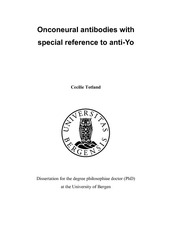Onconeural antibodies with special reference to anti-Yo
Doctoral thesis
Permanent lenke
https://hdl.handle.net/1956/5526Utgivelsesdato
2011-12-20Metadata
Vis full innførselSamlinger
Sammendrag
The mechanisms behind anti-Yo mediated paraneoplastic cerebellar degeneration is still not understood, and very little is known about the function of CDR2. In our studies we have tried to elucidate the properties of Yo antibodies, potential antibodies that coexist with anti-Yo and whether sequence variants in the CDR2 gene or differences in CDR2 transcription and expression could explain why some patients develop PCD. The avidity of antibodies is associated with onset of disease and disease severity, and the avidity of paraneoplastic antibodies has never been examined before. We compared differences in antibody avidity among patients with the two most common paraneoplastic antibodies, anti-Hu and anti-Yo. We found that the antibody avidity among patients with these antibodies was heterogeneous, but patients with Yo antibodies generally had antibodies with higher avidity than patients with Hu antibodies. This might reflect differences in the patient’s immune response, the severity of the disease or different time points of sampling. Since antibody avidity increase over time we also did a longitudinal study where we followed patients with Hu or Yo antibodies over time. This study showed that while the avidity indexes increased over time for most patients with Hu antibodies, the avidity indexes for patients with Yo antibodies were fairly constant. This could indicate that Hu antibodies are discovered at an earlier time point in the disease progress, while the Yo antibodies have persisted for a while before the neurological symptoms developed. More than 60 % of all ovarian tumours express CDR2, but only 2.3 % of these patients develop Yo antibodies and even fewer develop PCD. The reason why some patients develop paraneoplastic antibodies is not known. We wanted to study whether the production of Yo antibodies in some ovarian cancer patients were related to variants in the cDNA sequence or to difference in the CDR2 mRNA or protein level in tumour tissue from patients with ovarian cancer. We found no differences among the patients that could explain why some of them develop Yo antibodies and PCD. However, we observed that CDR2 was not solely expressed by tumour cells. Also normal ovarian tissue expressed low levels of CDR2. These findings indicate that CDR2 may be more widely distributed than previously reported. Our findings also support the hypothesis that development of PCD is not solely related to CDR2 expression and Yo antibody synthesis, but also to immune dysregulation, such as antigen presentation and cooperation between B and T cells. Yo antibodies most commonly appear alone. We identified a patient with PCD and Yo antibodies that also harboured antibodies towards a little described protein called CCDC104. We found that this protein was expressed in several tissues, especially brain and testis. We further investigated whether this antibody was a potentially new paraneoplastic marker. CCDC104 antibodies were not related to cancer or PNS. However, 10.5 % of the anti-Yo sera also had CCDC104 antibodies, suggesting there is a significant association between anti-Yo and anti-CCDC104.
Består av
Paper I: Totland C, Aarseth J, Vedeler C: Hu and Yo antibodies have heterogeneous avidity, Journal of Neuroimmunology 185(1-2): 162-167, April 2007. Full text not available in BORA due to publisher restrictions. The article is available at: http://dx.doi.org/10.1016/j.jneuroim.2007.01.016Paper II: Totland C, Aarskog NK, Eichler TW, Haugen M, Nøstbakken JK, Monstad SE, Salvesen HB, Mørk S, Haukanes BI, Vedeler CA.: CDR2 antigen and Yo antibodies, Cancer Immunology, Immunotherapy 60(2):283-289, November 2011. The article is available at: http://hdl.handle.net/1956/4552
Paper III:Totland C, Bredholt G, Haugen M, Haukanes BI, Vedeler, C: Antibody to CCDC104 is associated with a paraneoplastic antibody to CDR2 (anti-Yo). Cancer Immunology, Immunotherapy 59(2): 231-237, August 2009. Full text not available in BORA due to publisher restrictions. The article is available at: http://dx.doi.org/10.1007/s00262-009-0742-3
